Halloween
Halloween, October 31st, is a day in which candy is traditionally handed out to children. Halloween in recent years has become more of an adult oriented, secular celebration, which has been extensively embraced by the gay community and is sometime referred to as, "the gay Christmas".[1] Costume parties with traditional to very elaborate haunted house motifs became quite popular beginning in the mid-1980's. In 2010, Americans spent an estimated $800 million on costumes for children and $1 billion on costumes for adults. [2] In 2014, The National Retail Federation (NRF) forecasts total Halloween spending—including candy, costumes, and decorations—to come in at $7.4 billion and an additional $350 million just on Halloween costumes—for pets..[3] Halloween spending is expected to reach a record $13.1 billion this year, up from $11.6 billion last year and exceeding the previous $12.2 billion record set in 2023. [4]
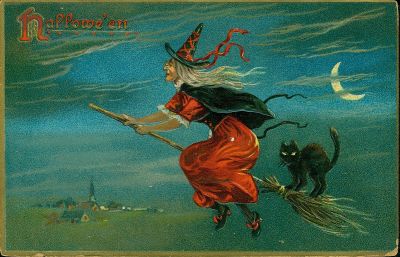
Halloween has never been a particularly popular holiday within the boylove community despite it's relationship to boys and our cultural crossover with the gay community. This is likely due to the myths that "pedophiles" kidnap and otherwise hurt children on Halloween. In spite of the fact that there is no documented proof of this ever occurring, some states have used these myths to justify prohibiting those labeled as sex offenders, ranging from rapists of women to men who were caught urinating outdoors, as well as the many thousands of children who have been placed on the sex offender registry [5] [6], from participating in Halloween related activities, including adding further restrictions on their freedoms and Human rights.[7]
"Kids aren’t the only ones letting their imaginations’ fears run wild on Halloween: parents, politicians, parole and police officers across the country are continuing to support laws that ban registered sex offenders from participating in Halloween", [8] by adding increasingly punitive restrictions based solely on fear.
According to Emily Horowitz, who is an associate professor of sociology at St. Francis College in Brooklyn, NY,
“ In North Carolina, a sheriff tells parents to check the online sex offender registry before allowing children to trick-or-treat. In Montana, a town offers a "trunk-or-treat" event where kids can get Halloween candy from trunks of cars in a parking lot to avoid potential danger. In New York, "Operation Halloween: Zero Tolerance" prohibits sex offenders from wearing masks or costumes or answering their doors on Halloween, and, as a parole source says, "There is certainly nothing more frightening than the thought of one of these men opening their door to innocent children." In Oklahoma, a city council is considering an ordinance forbidding sex offenders from decorating their homes or passing out candy on Halloween. In Orange, California, sex offenders can't answer their door or have outside lighting on Halloween, but an additional ordinance requiring window signs saying, "No candy or treats at this residence" was recently revoked after attorneys argued it was a form of cruel and unusual punishment. Why worry about sex offenders on Halloween? Research shows no evidence of increased child sex abuse on Halloween and no evidence that a child was ever a victim of sexual abuse by a stranger while out trick-or-treating. [9]
” — Emily Horowitz,
Associate professor of sociology
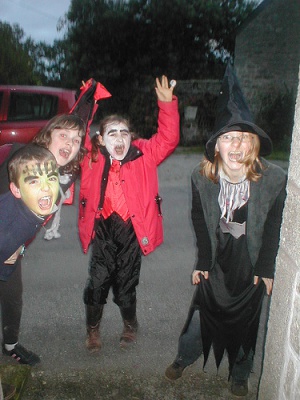
History and traditions
Halloween or Hallowe'en a contraction of "All Hallows' Evening"),[10] also known as Allhalloween,[11] All Hallows' Eve,[12] or All Saints' Eve,[13] is a yearly celebration observed in a number of countries on 31 October.
According to many scholars, All Hallows' Eve is a Christianized feast initially influenced by Celtic harvest festivals,[14] with possible pagan roots, particularly the Gaelic Samhain.[12][15][16] Other scholars maintain that it originated independently of Samhain and has solely Christian roots.[17]
Typical festive Halloween activities include trick-or-treating (or the related "guising"), attending costume parties, decorating, carving pumpkins into jack-o'-lanterns, lighting bonfires, apple bobbing, visiting haunted attractions, playing pranks, telling scary stories and watching horror films.[18]
Trick-or-treating
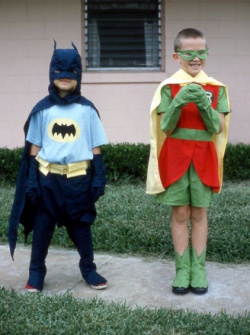
In the Pre-Christian era in Europe, it was believed that during Samhain, the veil between our world and the spirit world was thinnest, and that the ghosts of the deceased could mingle with the living. The historian Jack Santino says, "It was the biggest and most significant holiday of the Celtic year. The Celts believed that at the time of Samhain, more so than any other time of the year, the ghosts of the dead were able to mingle with the living, because at Samhain the souls of those who had died during the year traveled into the otherworld. People gathered to sacrifice animals, fruits, and vegetables. They also lit bonfires in honor of the dead, to aid them on their journey, and to keep them away from the living. On that day all manner of beings were abroad: ghosts, fairies, and demons--all part of the dark and dread."[19] The superstition was that the visiting ghosts could disguise themselves in human form, such as a beggar, and knock on your door during Samhain asking for money or food. If you turned them away empty-handed, you risked receiving the wrath of the spirit and being cursed or haunted.
Another Celtic myth was that dressing up as a ghoul would fool the evil spirits into thinking that you were one of them so that they would not try to take your soul. In the U.S., trick-or-treating became a customary Halloween tradition around the late 1950s, after it was brought over to America by Irish immigrants in the mid to late 1800s.[20]
The origin of the term trick-or-treat stem from the ancient practices of “souling” and “guising.” In the Middle Ages, poor people in Ireland and Britain would go “souling” on Hallowmas (November 1). “Souling” consisted of going door to door asking for food in return for saying prayers for the dead on All Souls Day (November 2)[21]
There are indications that term trick or treat in North America originated in Canada in the late 1920's.[22] The earliest known citation of trick or treat in print in the US is from an item in the Oregon newspaper The Oregon Journal, 1st November 1934, headed "Halloween Pranks Keep Police on Hop":
- "Other young goblins and ghosts, employing modern shakedown methods, successfully worked the 'trick or treat' system in all parts of the city." [23]
Jack-O'-Lantern
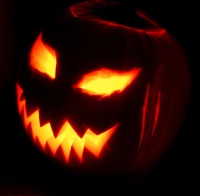
A jack-o'-lantern (or jack o'lantern) is a carved pumpkin, or turnip, and named after the phenomenon of strange light flickering over peat bogs in Ireland, called will-o'-the-wisp or jack-o'-lantern. Originally, the jack-o'-lantern was a carved turnip. When the Irish immigrants came to America in the mid-1800's, turnips were not commonly available and pumpkins were more accessible and much easier to carve out.
In a jack-o'-lantern, the top is cut off to form a lid and the inside flesh then scooped out; an image, usually a monstrous or comical face, is carved out of the pumpkin's rind to expose the hollow interior. To create the lantern effect, a light source (such as a candle or tea light) is placed within before the lid is closed. This is traditionally a flame or electric candle, though pumpkin lights featuring various colors and flickering effects are also marketed specifically for this purpose. It is common to see jack-o'-lanterns on doorsteps and otherwise used as decorations prior to and during Halloween.[24]
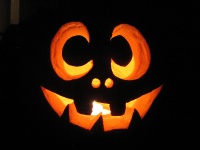
|
The origins of the Jack-O'-Lantern comes from an Irish folk legend about a boy named Jack (AKA Stingy Jack) who was a mischievous young boy who took pleasure in playing tricks on just about everyone. One day, he tricked the Devil into climbing up an apple tree. After the Devil climbed up the tree, Jack hurriedly placed crosses around the trunk of the tree. Unable to touch a cross, the Devil was stuck in the tree. Jack made the Devil promise him not to take his soul when he died. Once the devil promised not to take his soul, Jack removed the crosses, and the Devil climbed down out of the apple tree. Later, when he died, he was also denied access to Heaven and was stuck wandering the Earth. He carved out a turnip and stuck a burning ember inside to ward off evil spirits. This became known as Jack's Lantern.[25] [26] |
Black-eyed children
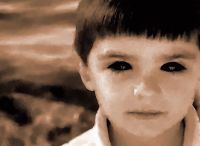
Black-eyed children or black-eyed kids are an American contemporary legend of paranormal creatures that resemble children between ages 6 and 16,[27] with pale skin and black eyes, who are reportedly seen hitchhiking or begging, or are encountered on doorsteps of residential homes.[28][29][30]
Their eyes are coal black. No pupil. No iris. They often want you to let them into your house or car and can be very persistent. They may seem like ordinary children at first, except for the eyes. There have been reports that their clothes may seems outdated or from a different era.
There is no indication of what their intentions might be except some people report a sense of dread in their presences.
Creepy clown hysteria
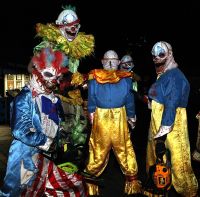
In the fall of 2016, Creepy clown hysteria swept across the USA and then went global. [31] Both children and adults reported sighting of menacing clowns, mainly on social media (esp.Twitter), and a number of reports were made to the police by parents and other adults upon hearing these stories or reading children's tweets to each other. This lead to a number of teenagers being arrested, some as young as 13, [32] and charges being brought for "terroristic threats and causing false alarm" for what were essentially Halloween pranks. No actual creepy clowns (vampires or werewolves) were arrested. Reports vary on how much this increased creepy clown costume sales however some estimates say as high as 300 percent. [33]
Other popular Halloween imagery
- The traditional Halloween colors are black & orange.
- Witches
- Ghosts and evil spirits
- Vampires and coffins
- Werewolves
- Frankenstein's monster
- Egyptian mummys
- Zombies
- Creepy clowns
- Skeletons and skulls
- Black cats
- Bats
- Rats
- Spiders and spider webs
- Ravens
- Black roses
- Chain saws
- Tombstones
- Scarecrows
- Satan, devils, and demons
- Goblins, evil elves, evil gnomes, and evil leprechauns
- Cornstalks and hay bails
- Scary Doctors/nurses and primitive medical equipment
Halloween myths intended to ruin people's enjoyment of the holiday
This section is comprised of those myths that are intended to ruin people's enjoyment of Halloween and that are being perpetuated by the tabloid media and other fear mongers. These myths are frequently used to influence public opinion and the actions of the government towards boylovers and other minor attracted people, as well as other marginalized groups such as registered sex offenders.
- There are many other myths and scary stories that are meant to enhance people's enjoyment of the holiday.(See:[1])
Myth #1: Evildoers use Halloween as an opportunity to poison children.
Nobody cannot definitively prove that no child has ever been hurt or killed by a stranger poisoning their Halloween candy, but no such event has ever been documented in the media. Many of the stories of children being poisoned were completely fabricated or greatly exaggerated. In 2021, police began warning of marijuana edibles being handed out as Halloween candy. There is no evidence that this has ever occurred. [34] [35]
Myth #2: Sex offenders and child abductors are on the prowl on Halloween night
Although cases of abduction do occur, the vast majority are by noncustodial parents.[36] Statistics show child abductions to be no more prevalent or numerous on Halloween than any other day of the year. There has not been a single case of any child being molested by a convicted sex offender while trick-or-treating.[37]
The pumpkin sticker campaigns
Parent’s Guide to Child Safety: seasonal safety says,
| “ | "The pumpkin sticker campaigns [38] and other community initiatives taken against sex offenders on Halloween are nothing more than an extravagant waste of community resources.
The vast majority of people on sex offender registries are not community rapists nor child abductors, and if you gathered 10,000 pedophiles in a room, the number who would even entertain the thought of abducting a child could be counted on one hand. (Most cases involve sexualized affection, not aggression, and most would never intentionally do a child harm.) Those few who would tend to serve long sentences when caught and don't end up in the community because of this, B) The odds are more than 100/1 that if a child is abducted or harmed, it will be at the hands of someone not on that list. More than 99% of the danger comes from your OTHER next-door neighbors and community members. In other words, those houses without the pumpkin sticker are more dangerous to your child by a factor of more than 100 times.[39] |
” |
Myth #3: Pedophiles and Sex offenders use candy and Halloween decorations to entice and lure children
This is the modern day equivalent of the gingerbread house myth from Hansel and Gretel.[40] There is no supporting evidence for this belief. However in many states, those convicted of sex offenses are not allowed to decorate the outside of their homes or have their outdoor lights on, or even answer their door on Halloween night.[41] [42]
References
- ↑ How Halloween became the gay Christmas
- ↑ Halloween craze started in gay culture
- ↑ Wait, Americans Spend How Much on Halloween?
- ↑ Halloween spending to reach record $13.1 billion
- ↑ When Kids Are Sex Offenders
- ↑ One in four child sex offenders are revealed as children - as more than 3000 young people have sexually assaulted kids in the past five years
- ↑ http://criminal.findlaw.com/criminal-charges/halloween-sex-offender-laws.html
- ↑ Halloween Sex Offender Laws Are Unjustified
- ↑ Manufacturing Fear: Halloween Laws for Sex Offenders
- ↑ Thomas Thomson, Charles Annandale (1896). A History of the Scottish People from the Earliest Times: From the Union of the kingdoms, 1706, to the present time. Blackie. http://books.google.com/books?id=YVgJAAAAIAAJ&q=Hallowe'en+contraction&dq=Hallowe'en+contraction&hl=en&ei=Y6i8TtXJOcargwe2lN28Bw&sa=X&oi=book_result&ct=result&resnum=5&ved=0CD8Q6AEwBDgK. Retrieved on 31 October 2011. "Of the stated rustic festivals peculiar to Scotland the most important was Hallowe'en, a contraction for All-hallow Evening, or the evening of All-Saints Day, the annual return of which was a season for joy and festivity."
- ↑ Palmer, Abram Smythe (1882). Folk-etymology. Johnson Reprint. p. 6.
- ↑ 12.0 12.1 Merriam-Webster's Encyclopædia of World Religions. Merriam-Webster. 1999. http://books.google.com/books?id=ZP_f9icf2roC&pg=PA408&dq=all+hallow's+eve+christian+origin&hl=en&ei=dUyvTrfhIYetgwen5YiCAg&sa=X&oi=book_result&ct=result&resnum=6&ved=0CE8Q6AEwBQ#v=onepage&q&f=false. Retrieved on 31 October 2011. "Halloween, also called All Hallows' Eve, holy or hallowed evening observed on October 31, the eve of All Saints' Day. The pre-Christian observances influenced the Christian festival of All Hallows' Eve, celebrated on the same date."
- ↑ NEDCO Producers' Guide. 31-33. Northeast Dairy Cooperative Federation. 1973. "Originally celebrated as the night before All Saints' Day, Christians chose November first to honor their many saints. The night before was called All Saints' Eve or hallowed eve meaning holy evening.".
- ↑ "Halloween." History.com. Retrieved 24 October 2013.
- ↑ Nicholas Rogers (2002). Halloween: From Pagan Ritual to Party Night. Oxford University Press. http://books.google.com/books?id=stWZ_UDteMIC&pg=PA22&dq=halloween+christian+holy+day&hl=en&ei=wCiwTu-tN8j00gGJ5bjGAQ&sa=X&oi=book_result&ct=result&resnum=9&ved=0CG8Q6AEwCA#v=onepage&q=halloween%20christian%20holy%20day&f=false. Retrieved on 31 October 2011. "Halloween and the Day of the Dead share a common origin in the Christian commemoration of the dead on All Saints' and All Souls' Day. But both are thought to embody strong pre-Christian beliefs. In the case of Halloween, the Celtic celebration of Samhain is critical to its pagan legacy, a claim that has been foregrounded in recent years by both new-age enthusiasts and the evangelical Right."
- ↑ Austrian information. 1965. http://books.google.com/books?id=9FU7AQAAIAAJ&q=all+hallow's+eve+wear+masks+Christian+souls+vengeance&dq=all+hallow's+eve+wear+masks+Christian+souls+vengeance&hl=en&ei=u1CvTtjjFOKHsAKEudDkAQ&sa=X&oi=book_result&ct=result&resnum=1&ved=0CC0Q6AEwAA. Retrieved on 31 October 2011. "The feasts of Hallowe'en, or All Hallows Eve and the devotions to the dead on All Saints' and All Souls' Day are both mixtures of old Celtic, Druid and other pagan customs intertwined with Christian practice."
- ↑ Rogers, Nicholas (2003). Halloween: From Pagan Ritual to Party Night. Oxford University Press. p. 22. ISBN 9780195168969. "Festivals commemorating the saints as opposed to the original Christian martyrs appear to have been observed by 800. In England and Germany, this celebration took place on 1st November. In Ireland, it was commemorated on 20th April, a chronology that contradicts the widely held view that the November date was chosen to Christianize the festival of Samhain."
- ↑ Halloween From Wikipedia
- ↑ Halloween: The Fantasy and Folklore of All Hallows by Jack Santino
- ↑ http://www.livescience.com/16677-halloween-superstitions-traditions.html Kids Trick-Or-Treating in Costumes Trick-Or-Treating in Costumes
- ↑ Why do you say “trick or treat”?
- ↑ Why Do We Say “Trick or Treat”?
- ↑ The meaning and origin of the expression: Trick or treat?
- ↑ Jack-o'-lantern from Wikipedia
- ↑ Irish Origins: Legend of Jack
- ↑ Jack O'Lanterns and The Tale Of Stingy Jack
- ↑ Mikkelson, David. FACT CHECK: White-Eyed Children.
- ↑ The definitive guide to creepypasta—the Internet's "scariest" urban legends (31 October 2012).
- ↑ Behind black eyes: Reports of spooky black-eyed kids. randi.org.
- ↑ Clench, Sam. "Black eyed children: Real, or just a creepy myth?", NewsComAu, 19 November 2013.
- ↑ What Do the Scary Clowns Want?
- ↑ 13-year-old arrested as 'creepy clown' craze hits South Jersey
- ↑ Clown costume sales see 300 percent increase
- ↑ Police warn of marijuana edibles that look like candy ahead of Halloween
- ↑ The Myth About Strangers Poisoning Kids’ Halloween Candy
- ↑ 40 Uncommon Parental Child Abduction Statistics
- ↑ Tricks-Not-Treats: Halloween Predator Panic Laws
- ↑ Pumpkin symbol marks sex offenders’ homes
- ↑ SEASONAL SAFETY: Parent’s Guide to Child Safety
- ↑ Hansel and Gretel from Wikipedia
- ↑ Halloween Hysteria
- ↑ Sex offenders locked down, in the dark for Halloween
See also
- Kids, watch out for cars on Halloween (News Article)
- The Gingerbread House Myth (News Article)
- Send in the clowns - 2016, Clown hysteria sweeps the nation across the USA, and then goes global. (News Article)
- The Walking Dead
- Sex offender registry
External links
- Sex offenders not required to post signs on Halloween
- Parole agents take the streets for Operation Boo
- Halloween Sex Offender Laws Are Unjustified
- Fear the Bogeyman: Sex Offender Panic on Halloween
- Is Halloween Candy Tampering a Myth?
- Trick-or-treating nightmares are urban legends
- Sex Offender Pleads No Contest (Halloween candy)
- The official yearly Halloween report
- The only thing we have to fear on Halloween is fear itself
